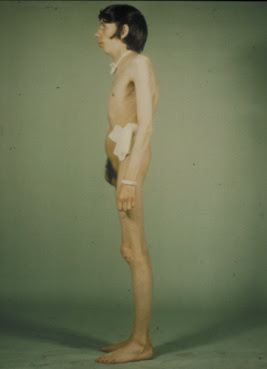Marfanoid habitus - Symptoms, Causes, Treatment
Marfan habitus is a condition whose symptoms are mostly resembling with the symptoms of a disease called Marfan syndrome. The symptoms resembling are associated with skeletal system of the patient. The only difference between marfan habitus and Marfan syndrome is the presence of aortic and eye problems in Marfan syndrome. It is considered a genetic disorder which is associated with connective tissues of skeletal system.
In marfan habitus, the body become thin and lean with longer limbs specially hands along with fingers than the usual length. This condition is associated with a special body shape. This condition also resembles with ad disease named hypermobility syndrome. The following measurements are the parameters to assess this condition:
The bending of the spinal area occur which is may be more than 5 degrees along with the sternum enhanced outward showing abnormal breast presence and the curve of the palate in mouth increases in size.

There are limited causes reported behind the marfanoid habitus and these are as follows:
This condition mostly occurs when there is a defect in genetics, like the genes transported to baby are without a specific mutation in them, and this lack of mutation in genes is the main cause behind marfanoid habitus. It is a connective tissue disorder associated with skeletal system. So any kind of trauma to these tissues may also lead to marfanoid habitus. The person with MASS phenotype and the mitral valve prolapse syndrome are more susceptible to this condition as these two are also associated with lack of gene mutation.
The most common symptoms reported with marfanoid habitus are as fatigue (as patient feels exhausted and can’t walk briskly), insomnia (the sleep cycle of these patients is short), mood swings mostly remain in anxious mood, depression is also the symptom reported, pain in limbs `and stress on limbs and no proper functioning in routine life. Along with all these symptoms, dilation in aorta is also seen, and the pulmonary artery is also enlarged. The patient become thin and lean and the upper part of body becomes tall along with limbs.
The patient with marfanoid habitus requires a proper treatment which may be through medications or surgery. The proper management is also needed after treatment. Decongestants and caffeine should be avoided. Beta blockers i.e. atenolol are included in medication which reduce the dilation of aorta. The expecting mothers should be counselled properly to treat the condition so that it could not transfer to baby. Calcium antagonists are also given in treatment. ACE inhibitors i.e. perindopril are also useful as they reduce the pressure on arteries. Doxycycline suppress the appearance of this condition. Surgery of aorta is another option used rarely.
In marfan habitus, the body become thin and lean with longer limbs specially hands along with fingers than the usual length. This condition is associated with a special body shape. This condition also resembles with ad disease named hypermobility syndrome. The following measurements are the parameters to assess this condition:
- The length of arm to height ratio of patient > 1.03
- The length of hand to height ratio of patient > 11% same for toes.
- The length of foot to height ratio of patient > 15%
- The upper body part to lower one ratio < 0.89
The bending of the spinal area occur which is may be more than 5 degrees along with the sternum enhanced outward showing abnormal breast presence and the curve of the palate in mouth increases in size.

Marfanoid habitus Causes
There are limited causes reported behind the marfanoid habitus and these are as follows:
This condition mostly occurs when there is a defect in genetics, like the genes transported to baby are without a specific mutation in them, and this lack of mutation in genes is the main cause behind marfanoid habitus. It is a connective tissue disorder associated with skeletal system. So any kind of trauma to these tissues may also lead to marfanoid habitus. The person with MASS phenotype and the mitral valve prolapse syndrome are more susceptible to this condition as these two are also associated with lack of gene mutation.
Marfanoid habitus Symptoms
The most common symptoms reported with marfanoid habitus are as fatigue (as patient feels exhausted and can’t walk briskly), insomnia (the sleep cycle of these patients is short), mood swings mostly remain in anxious mood, depression is also the symptom reported, pain in limbs `and stress on limbs and no proper functioning in routine life. Along with all these symptoms, dilation in aorta is also seen, and the pulmonary artery is also enlarged. The patient become thin and lean and the upper part of body becomes tall along with limbs.
Marfanoid habitus Treatment
The patient with marfanoid habitus requires a proper treatment which may be through medications or surgery. The proper management is also needed after treatment. Decongestants and caffeine should be avoided. Beta blockers i.e. atenolol are included in medication which reduce the dilation of aorta. The expecting mothers should be counselled properly to treat the condition so that it could not transfer to baby. Calcium antagonists are also given in treatment. ACE inhibitors i.e. perindopril are also useful as they reduce the pressure on arteries. Doxycycline suppress the appearance of this condition. Surgery of aorta is another option used rarely.
Marfanoid habitus - Symptoms, Causes, Treatment
 Reviewed by Simon Albert
on
April 14, 2017
Rating:
Reviewed by Simon Albert
on
April 14, 2017
Rating:
 Reviewed by Simon Albert
on
April 14, 2017
Rating:
Reviewed by Simon Albert
on
April 14, 2017
Rating:











